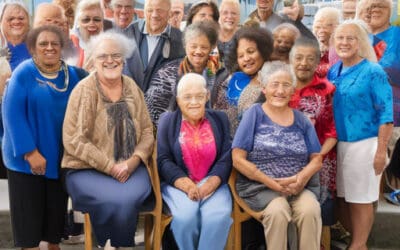Modernizing Independent Assisted Living: Technology Integration
Technology has transformed independent assisted living facilities in recent years. These improvements promise to improve residents’ quality of life and streamline community management and care. As older persons become more numerous, cutting-edge technologies in independent living settings are vital.

Independent living centers integrate technology to improve safety, health monitoring, and social connectivity to help people stay independent and get the care they need. Smart home systems are a crucial technology here. These systems can automate lighting, temperature, and security to occupants’ preferences. Motion sensors can alter illumination based on the time of day and resident activity, decreasing overnight bathroom falls.
Another critical technology is wearable health gadgets. These gadgets monitor heart rate, sleep habits, and physical activity, detecting falls and immediately warning staff and medical personnel. The data obtained can be used for quick reactions and long-term health monitoring, enabling individualized care plans that adapt to each resident’s changing health.
Independent living communities use telemedicine systems, too. These technologies enable virtual doctor sessions, making medical advice more accessible and minimizing hospital trips. This benefits mobility-challenged residents and those living far from major medical centers.
In independent assisted living, social interaction tools have helped older persons avoid loneliness and isolation. Residents can stay in touch with family and friends via video conversations, social networking, and virtual reality experiences that imitate being together. Residents in some communities can interact with robots for companionship and cognitive rehabilitation.
Cognitive aid technologies have several benefits. These include apps and devices that remind memory-impaired residents about medicines, appointments, and social gatherings. Interactive activities that improve cognitive function can also be fun and soothing for residents.
Emergency response technology has advanced. Modern independent living communities have advanced emergency call systems. Residents can call for aid by pressing a pendant, bracelet, or voice-activated gadget. This quick response prevents small situations from becoming significant emergencies.
When implemented, these devices have privacy and adaptability issues. Technology has many benefits, but its pervasiveness poses privacy and data security risks. Residents and their families require guarantees that their data is secure and protected.
Technology in independent living situations also requires residents to adjust, as many may need to become more accustomed to these new technologies. All residents must be trained and supported to utilize technology confidently and effectively.
Despite these limitations, technological integration in independent assisted living is favorable and growing. Technology has great promise to improve independent living in the future. AI-driven predictive analytics might personalize care plans, while robotics could make more advanced robotic helpers essential to daily living.
As technology advances, so will its use to improve independent assisted living. With rigorous ethical thought and user-friendly designs, these technological integrations will continue to change independent living, making it safer, more comfortable, and pleasurable for all inhabitants. As we adopt new technologies, we must ensure they are accessible and helpful to all, paving the way for a future where technology and care work together to enhance our aging population’s dignity and freedom.

Legal and Financial Issues in Independent Assisted Living
Instead of just choosing a lovely living setting, independent assisted living means navigating intricate legal and financial waters. Understanding these elements helps seniors and their families make informed decisions that assure security and compliance with rules. Each piece contributes to independent living sustainability, from financial planning and legal documentation to government aid programs.
Understand independent assisted living costs before starting this path. Costs vary by location, services, care needed, and facility features. Institutions typically charge for accommodation, utilities, meals, daily help, and medical care. Reviewing personal resources and prospective income sources, including pensions, savings, investments, and social security benefits, is typical when planning for these costs.
Many use long-term care insurance to control these costs. These plans can help pay for assisted living, reducing the financial load. However, each insurance policy covers different things, so it’s essential to understand them before buying. This involves rigorous policy study and potential contact with a long-term care insurance-savvy financial counselor.
Apart from insurance, legal preparedness is essential. Legal counsel for independent assisted living generally encompasses healthcare and financially durable powers of attorney. If the resident becomes incapacitated, a healthcare power of attorney permits a chosen person to make medical choices. A financial power of attorney allows a trusted individual to manage finances, which is essential for stability and timely payment.
A living will or advance healthcare directive is essential in independent assisted living. This paper states a person’s medical treatment wishes if they cannot communicate. It protects residents’ healthcare preferences, especially in end-of-life situations.
Trusts can be important for many families planning for assisted living. They administer and safeguard assets and pay for care. Depending on their structure, trusts may also provide tax benefits and help maintain Medicaid eligibility for ongoing care expenses.
Financial planning for independent assisted living must also take Medicaid eligibility into account. Understanding one’s state’s Medicaid requirements and asset limits is crucial. Legal guidance is often needed to negotiate Medicaid planning, including spending down assets without jeopardizing eligibility.

Veterans may receive additional government support from the Department of Veterans Affairs. Veterans and their spouses who need assisted living might benefit financially from programs like Aid and Attendance. Starting early and engaging a qualified counsel is advised because applying for these benefits can be complicated and lengthy.
Financial considerations for independent assisted living include medical and long-term care tax deductions. Income taxes may deduct assisted living facility fees, notably medical treatment. Significant tax savings can reduce the overall financial load.
Managing the financial and legal components of independent assisted living involves financial foresight, legal protection, and strategic resource usage. By addressing these issues, individuals and families can ensure a seamless and secure transition to independent assisted living. This gives seniors peace of mind and preserves their dignity and independence as they enter this new period of life. It’s essential to consult financial planners, insurance specialists, and lawyers because these processes are complicated, and the stakes are high. Comprehensive preparation and informed decision-making can help persons who choose assisted living have a stable and fulfilling future.



